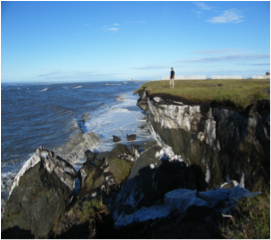About Landscape Conservation Cooperatives
Facilitated by the Department of the Interior, Landscape Conservation Cooperatives (LCCs) were established to provide a collaborative approach to conservation management. An initial federal investment of $25 million in 2010 funded the first nine LCCs of the 21 planned across North America. The LCCs will collectively form a network of resource managers, scientists, and public and private organizations with common interests in conservation. By leveraging existing resources and developing science-based tools, the network of LCCs will inform resource management decisions regarding the sustainability of natural systems and landscapes under stressors such as rapidly changing climatic conditions.
The Arctic Landscape Conservation Cooperative

The Arctic Landscape Conservation Cooperative (ALCC), one of the first LCCs formed, is a self-directed partnership that functions through a multi-tiered structure of at-large partners, a core staff, and a steering committee of cooperating agencies and organizations. Its geographic scope ranges across North America from Alaska to Labrador. The Alaska portion encompasses three eco-regions: the Brooks mountain range, the arctic foothills, and the arctic coastal plain. These areas provide critical breeding grounds and habitat for dozens of bird and mammal species.
The Arctic presents extraordinary challenges for resource managers who must anticipate the effects of climate-associated habitat change and incorporate that understanding into conservation planning. The rapidly warming climate is associated with significant changes already observed in arctic terrestrial landscapes, such as:

Summer sea ice pulling away from the coast, exposing coastlines to increased rates of erosion and severity of storm surges while reducing habitat for ice-obligate species.
An increasingly thick layer of the tundra actively thawing during each growing season, which influences both stream flow patterns and the probability that lakes will be tapped and drained into adjacent fluvial systems. These changes in surface hydrology, coupled with precipitation and evaporation-transpiration changes, affect the timing and severity of tundra drying. This affects the vegetation community composition and increases the probability of severe and extensive tundra fires.
Arctic breeding birds that migrate based on the solar calendar may become decoupled from their invertebrate food sources, which emerge based on temperature. Emerging chicks hungry for insects may hatch too late to take advantage of the peak insect abundance that was once timed perfectly to suit their needs.
Shrub cover is increasing in the Brooks Range and foothills, and warming is expected to favor increased shrub cover, at the expense of sedges and lichens.

In the face of such fundamental climate-driven changes, land managers remain uncertain of exactly how things will change on any given parcel of arctic landscape. In order to make crucial planning decisions, managers need improved scientific information and tools such as the development of vulnerability assessments for individual species, the compilation of widely scattered data sets, and access to those datasets. Working in collaboration with its partners, the Arctic LCC seeks to provide these tools.
The conservation goals of the Arctic LCC are to provide information on, and predict effects of, climate driven changes and other landscape stressors; determine how climate driven changes affect subsistence users; and provide improved data and information access to managers. During its initial stages the ALCC’s science priorities were heavily influenced by previous assessments of arctic science needs including the USFWS WildREACH report and the North Slope Science Initiative’s Emerging Issues papers.
Arctic LCC Science & Data Efforts
The Arctic LLC funded approximately $2 million in climate-related research and data synthesis efforts in 2010, with an equal amount of support leveraged in the form of in-kind contributions of labor and funding from other agencies and non-governmental organizations. One product of this initial cycle is the “Connecting Alaska Landscapes into the Future” report. The project used a climate envelope modeling approach to assess how future climate scenarios match mean temperature and precipitation conditions of the years 2000 to 2009. Results suggest that approximately 60% of Alaska may experience a shift to a new climate biome during the twenty-first century.
Approximately $1.3 million of funding from the Arctic LCC and $1 million in leveraged work will support over two dozen distinct research and data synthesis projects during 2011. With a long-term science plan under development, the ALCC Steering Committee used an interim selection process to rank proposals based on responsiveness to ALCC goals, feasibility, degree of partnering, responsiveness to management concerns, and a number of other criteria. Currently, six technical working groups—permafrost, coastal processes, climate modeling, hydrology, arctic biology, and geospatial data—are providing input to the development of the Arctic LCC science plan, which will guide future project funding strategies. A draft of this plan will be available for comment in late 2011.
For more information, see the Arctic Landscape Conservation Cooperative website: http://alaska.fws.gov/lcc/arctic.htm, or contact Greg Balogh, Arctic LCC Coordinator (Greg_balogh [at] fws.gov).
Arctic Landscape Conservation Cooperative Steering Committee Member Agencies
National Park Service
Bureau of Land Management
U.S. Fish and Wildlife Service
U.S. Geological Survey
Bureau of Ocean Energy Management, Regulation and Enforcement
U.S. Arctic Research Commission
U.S. Army Corps of Engineers
National Oceanic and Atmospheric Administration
Alaska Department of Fish and Game
